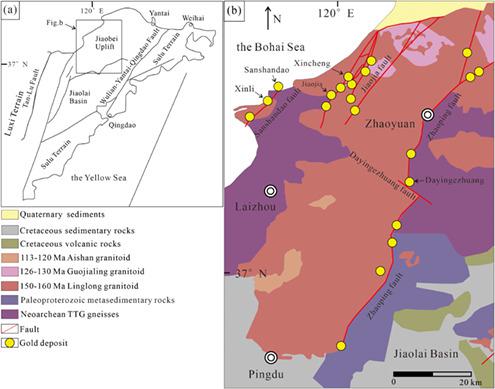当前位置:
X-MOL 学术
›
Resour. Geol.
›
论文详情
Our official English website, www.x-mol.net, welcomes your
feedback! (Note: you will need to create a separate account there.)
Metal source of gold deposits in the Jiaoxibei area, Eastern China: Insights from trace element analysis of gold and pyrite
Resource Geology ( IF 1.1 ) Pub Date : 2021-09-29 , DOI: 10.1111/rge.12278 Jilong Lu 1 , Yuchao Fan 1, 2 , Yechang Yin 3 , Yuxin Xiong 4 , Jinke Guo 1 , Wu Tian 1 , Xinyun Zhao 1
Resource Geology ( IF 1.1 ) Pub Date : 2021-09-29 , DOI: 10.1111/rge.12278 Jilong Lu 1 , Yuchao Fan 1, 2 , Yechang Yin 3 , Yuxin Xiong 4 , Jinke Guo 1 , Wu Tian 1 , Xinyun Zhao 1
Affiliation

|
The metal source of gold deposits in the Jiaoxibei area, eastern China, has been investigated by many researchers, but no consensus has been reached so far. In this study, three typical gold deposits, the Xinli, Jiaojia, and Dayingezhuang deposits, were selected for trace element analysis of gold and pyrite to constrain the metal source. Pyrite from these three deposits has similar morphological and compositional characteristics, and can be divided into three types: Py1 with euhedral to subhedral textures, Py2 with subhedral to anhedral textures with micro-fractures, and Py3 with subhedral to anhedral textures and intergrowing polymetallic sulfides. Among them, Py2 and Py3 were formed in the main ore-forming stage and they are the dominant host minerals of visible gold. In these deposits, visible gold occurs mainly in micro-fractures or as inclusions in Py2 and Py3. Most of the pyrite has extremely low concentration of invisible gold, indicating that visible gold in the Jiaoxibei district is not a product of the remobilization of invisible gold from earlier pyrite. Both Py2 and Py3 are characterized by low Co concentration of <100 ppm and Co/Ni ratio of <1, which are similar to those of pyrite in sedimentary rocks. Therefore, ore-forming metals of these gold deposits in the Jiaoxibei district may originate mainly from a sediment-related metal source.
更新日期:2021-09-29











































 京公网安备 11010802027423号
京公网安备 11010802027423号